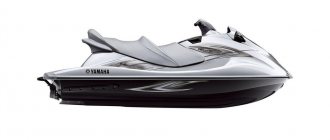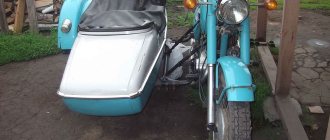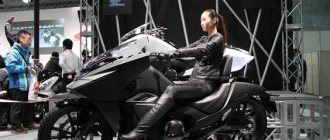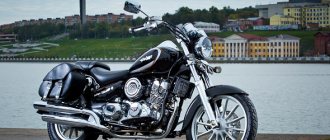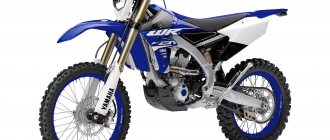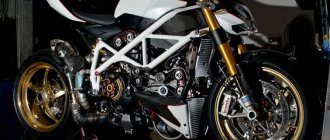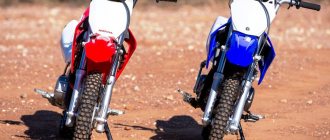- Classification of jet skis
- Jet ski device
- Operating principle of jet skis
- Advantages of BRP jet skis
- Varieties
- Selection by parameters
- Models for Beginners
- Choosing a used jet ski
- Infographics
“Hydrocycle”/“aquabike”/“jet ski” is the name of the same type of water equipment; it is a complex technical device designed for movement on water, which, due to its external similarity, is often called a jet ski. According to the GIMS classification, this is a “small vessel”. Once upon a time, jet skis were used only in sports competitions, but today they are increasingly found in places where active water recreation is developed. A hydrocycle, as a watercraft, is a metal-plastic body with an internal combustion engine and a water-jet propulsion system. To understand how a jet ski works, you need to understand its main types.
Classification of jet skis
“Stand-up” jet skis are not easy to operate and require certain sports skills. They reach speeds of up to 120 km/h. These jet skis are usually ridden by freestylers who can make spectacular turns and jumps. On such models you can always adjust the inclination of the water cannon nozzle, adjusting it for each trick.
“Sedentary” - designed for long boat trips. Designed for active recreation on the watery expanses of large reservoirs and rivers. Sit-on jet skis come in two-seater and three-seater versions. And although they are inferior in power and maneuverability to stand-up jet skis, they are also used to tow water skiers, inflatable balloons and cheesecakes.
If you need a jet ski for yourself to enjoy on the water, pay attention to the sit-on models. Standing ones are recommended for experienced athletes.
Ways to reduce fuel consumption
If you need to reduce fuel consumption, then you need to follow some rules when traveling on a jet ski.
- Operate it more carefully, without jerking, try to start moving and brake as smoothly as possible;
- Do not overload the jet ski with unnecessary things and carry passengers to a minimum;
- Monitor the condition of the engine and all equipment parameters. In normal and serviceable condition, fuel will be consumed much less and the safety of the crew will depend on this.
Jet ski device
- A body that can be made of high-strength plastics and other polymer materials, reinforced with metal inserts. The shape of the jet ski allows it to be maneuverable and quite easy to control. The case also has an insulated compartment for things that can be protected from water ingress.
- The engine is reliably protected from water. It is located inside the body of the jet ski and is the heart of this device.
- Cooling system (it can be closed or open type).
- Steering system (determines the direction of movement of the jetski). Taxiing is carried out by changing the horizontal angle of the water jet. The turning radius also depends on how sharply the driver turns the steering wheel.
- Additional technical devices. Driving a jet ski today can be more comfortable than, for example, 10 years ago. Many models have navigation, echo sounder, rear view mirrors and even water braking.
Jet skis are often used in regions where there is sea, lakes, rivers and other large bodies of water. It is not recommended to drive along narrow rivers with rock rapids, as this can lead to injury. The scope of application of jet skis is presented:
- boat excursions to the sea or by the lake - this is an excellent opportunity to have a “breezy” ride; usually the vacationer sits in the passenger seat and is taken for a ride by an experienced driver;
- independent walks along reservoirs - from the water you can look at beautiful landscapes from a different perspective;
- domestic sphere - jet skis can be used for fishing and in the household, for example, for transporting small loads.
- sports competitions - athletes compete with each other both at the regional and international levels;
Operating principle
The operating principle of a modern jet ski is very similar to household devices - a lawn mower, a chainsaw. Jet skis operate on two- or four-stroke engines. The power unit of the first version of the jet ski is equipped with two or three cylinders, the second version of the vehicle is usually equipped with four cylinders. The main difference from ground transport is the unique cooling system. Engine temperature control is ensured by supplying cold water directly from the reservoir.
The principle of starting a jet ski is similar. Its mechanism is activated by the ignition button, which is located directly on the steering wheel. How does a jet ski work? It's simple - the ignition button activates the starter, which, in turn, rotates the crankshaft and actually starts the power unit itself.
Operating principle of jet skis
The engine of a modern jet ski starts only if a special key is inserted into the lock, which is attached with a flexible cord to the life jacket of the person driving. This principle is intended to ensure safety and emergency engine shutdown. In case of possible fall of the helmsman, the key will be automatically pulled out and the engine will stop working. This reduces the risk of an uncontrolled watercraft colliding with another vessel or with an obstacle at high speed.
Neutral and reverse gears
To engage neutral, first shift into reverse and then push the lever back until the watercraft stops. The reverse flap will be in the middle position, throwing part of the water flow towards the front of the watercraft, thereby reducing its speed.
Warning
Never use jet propulsion components as a support point when lifting aboard a watercraft. Operate the shift lever only when the engine is idling and the watercraft has come to a complete stop. When reversing, never increase engine speed. Do not use reverse gear to stop the watercraft. If possible, drive in reverse for short periods of time and at low speeds. Always make sure there are no obstacles or people behind you, especially children playing in shallow water.
When the transmission is in neutral, the drive shaft and impeller continue to rotate.
Warning
For maximum control of the watercraft when reversing, increase the engine speed slightly. Excessive increase in rotation speed will lead to turbulence in the water flow and reduced operating efficiency.
When reversing, turn the steering wheel in the same direction you want to turn. For example, in order for the rear of a jet ski to turn left, the steering wheel must be turned to the left.
Operate the shift lever only when the engine is idling and the watercraft has come to a complete stop. Do not use reverse gear to stop the watercraft.
Advantages of BRP jet skis
BRP jet skis have been on the market for over 50 years, since 1968. This company has always been ahead of its competitors and was the first to introduce to the world a jet ski model with a four-stroke engine. BRP was also the first to present a jet ski with an engine of more than 200 horsepower. They could accelerate faster and outpaced their predecessors in top speed.
Subsequently, other manufacturers of jet skis took advantage of BRP’s developments and implemented these solutions in their devices. But some advantages of BRP still remain unique:
- OTAS - an electronic system that affects taxiing on the water;
- iBR is a modern braking system.
BRP influences the decisions of all jetski manufacturers and sets leading trends in the industry. All BRP models are characterized by:
- reliability (BRP jet skis use only high-quality parts that do not fail for a long time; they also require regular maintenance);
- affordable price (in terms of price-quality ratio, BRP jetskis have become market leaders, they have surpassed their competitors and have reached the point where they can independently set current trends);
- intelligent gas supply control system;
- 60-liter fuel tank;
- dry weight about 400 kg;
- unpretentiousness in maintenance (this is facilitated by the simple design of the engine and housing).
Among the offers from the manufacturer BRP there are both amateur models suitable for beginners and sports jet skis designed for experienced jet ski drivers and competitions at a professional level.
Popular manufacturers
Among the huge number of offers, there are several reliable companies that produce jet skis. The products combine quality and long service life. The funds invested in the purchase are fully justified and are repaid with true pleasure from use. In the question of how to choose a powerful jet ski, the manufacturing brand plays an important role.
BOMBARDIER BRP
The first company to produce a jet ski. It was presented back in 1968; the jet ski was part of a series that to this day unites the newest generations of motorcycles. The main difference between the manufacturer and competing organizations is the latest technologies and exemplary equipment. A sports jet ski with a 4-stroke engine was first released under this brand. Now the manufacturer is not inferior to the first positions among similar companies, constantly improving the functions of the units.
YAMAHA
A famous Japanese concern known throughout the world. The bike from this company was first released in 1986, attracting everyone's attention with its super-powerful engine and newfangled design. The company is actively expanding its product range, adding models of children's jet skis.
HONDA
This brand is not inferior in popularity. Experts have developed units that are distinguished by excellent performance and decent design. They currently do not release any new products.
KAWASAKI
The Japanese do not want to go into the shadows and present interesting new products. For a long time, the company produced exclusively stand-up models of jet skis. Following modern customer preferences, the brand has diversified its range. Sustainable and sporty luxury bikes also have their downsides. In the event of a breakdown, it is almost impossible to find the necessary spare part.
Types of BRP jet skis
All jetskis can also be divided into: amateur, family and sports. There are also luxury models that are characterized by the presence of the most modern technical equipment. The most popular models include:
- Sea-DooSpark is a jet ski designed for the whole family. It was developed over 7 years, and then tested for three years. The model presented on the market today has already received various awards around the world both for its characteristics and design. There are 2-seater and 3-seater jet skis. They are easy to operate, and fuel consumption is very economical - only 8 liters per 100 km. This water scooter weighs 165 kg (for 2 seats) and 205 kg (for 3 seats).
- The Sea-Doo GTX Limited 300 is a top-of-the-line luxury model with 300 horsepower. The seat here is very comfortable, it follows the natural curves of the body. “Luxury” is represented by additions in the form of a waterproof bag, a USB port and a special case. The manufacturer also made sure that there were sensors that determine the water temperature and the depth at which the water vehicle is currently located. This model features an exclusive bright color. Many people choose this jet ski for water trips to use the removable seat: it can be folded out, and then there will be enough space on the jet ski to sunbathe in the middle of open water.
- The GTI 90 is a budget model that BRP released in 2020. Despite its novelty, it quickly became a favorite among other proposals. 90 “horses” are more than enough to move with pleasure in both fresh and salt water. The body of the aquabike is made of polytec material, it is scratch-resistant. There is also an ITC system on board that helps control the gas supply depending on the situation. There are three modes: Touring, Eco and Sport. The jet ski is equipped with a modern IBR braking system, which allows you to quickly reduce speed in any conditions. There is a special trunk for things with a compartment protected from moisture.
What is the correct name and general characteristics of a jet ski?
Jet skis can often be found at Russian seaside resorts. However, in other cities this type of water transport is often not so developed, and many people do not know anything about it:
- So, it’s no secret to many that a jet ski is called a jet ski. This name well reflects the very close contact of this type of transport with water. After all, the root “hydro” most often refers to things that come into very close contact with moisture. Therefore, you can forget other names, like scooters or some others, because a jet ski is correctly called a jet ski. Currently, there are so many jet skis in the world that on almost every beach of different resorts you can meet people who cut through the waves with the help of this transport;
- A jet ski or jet ski is a type of water transport designed to move on the surface of the water. Moreover, this movement occurs through sliding. The main unit that gives power to a jet ski is the so-called internal combustion engine. Thus, this vehicle is quite powerful and strong, it gains quite a lot of horsepower;
- however, this is its advantage. After all, jet skis are mainly intended for all kinds of water activities. Some people just ride this jet ski, others prefer to perform some maneuvers, tricks and turns. Still others practice wakeboarding using jet skis. In a word, there are very, very many options for how to use a jet ski;
- The average length of jet skis is approximately 3 meters. They are quite long, although they look quite compact, comfortable and small. This water vehicle is capable of transporting quite heavy and weighty things. Their weight can reach up to 300 kilograms. As for the power of jet skis, the maximum speed to which they accelerate is approximately 150 kilometers per hour. This is a fairly high figure for water transport;
- There are several types of jet skis. On the first main type of jet ski, the one who controls this water transport must always stand. This way he is able to perform many more tricks and all kinds of maneuvers. Such jet skis are most suitable for all kinds of competitions and different sports. It is in this position that real shows can be shown. To drive such jet skis you need to have certain skills and good riding experience;
- There is a second main type of jet ski, which is used for riding in a sitting position. Such units are not very well suited for performing various tricks and maneuvers. Thus, most often these jet skis are chosen for all kinds of walks, hikes, and leisurely trips along the water surface. Although you can arrange a walk with the breeze - no one has canceled this. It’s just that on this type of jet ski, some tricks and feints that you can perform will be difficult;
- There is also a special group of jet skis - these are jet skis for fishing. Today, jet skis are often used for fishing. Although many people often associate it with a sportier mode of transport. But some manufacturers even emphasize that their scooters are designed for fishing and hunting. A jet ski for fishing is distinguished by more impressive dimensions and larger dimensions. In addition, a jet ski for fishing is sometimes equipped with a faster and more powerful outboard motor. After all, he must be very hardy;
- In order to choose a jet ski for fishing, the easiest way is to turn to online catalogs, since you can rarely find such a special type of water scooter in stores. Although in general the fishing jet ski meets all the basic standards and characteristics of a classic jet ski;
- Today, jet skis are used for quite a wide range of purposes. For example, certain types of water competitions that use jet skis are very common. By the way, recently, various beach lifeguards have also begun to use jet skis;
- If we mention a little about the history of the creation of the jet ski, it is worth noting that this is a fairly old watercraft, which was created back in 1968. Interestingly, jet skis were originally conceived as a unique type of transport for water competitions. And initially this water vehicle was created as swimming skis. But it is interesting that as this water transport developed, it turned out to be nothing more than a jet ski. To the very first sketches of this vehicle they simply added an electric start, a comfortable seat, steering wheel controls and a fairly flat bottom.
How to choose a jet ski based on parameters?
- Engine power. It will determine what speed the jet ski will develop and how sharply it can maneuver.
- Technical equipment. Braking, control systems and other features affect the driving characteristics of the vehicle.
- Case quality. It must be made of durable and damage-resistant materials.
- The presence of a box protected from moisture. It should fit everything you need and valuable (money, phone, documents).
- Seat ergonomics. They should be comfortable and safe to sit on.
- Design. By purchasing luxury models, you can choose how stylish your watercraft will be. Pay attention to color, shape and other features.
Having decided on the budget and the purpose for which the jet ski will be used, you can proceed to get acquainted with the BRP models according to the main parameters.
SUPER JET
A stand-up jet ski is a special type of water transport that requires special skills and rewards the owner with an endless charge of positive emotions. Ready to take your experience to the next level? There is only one choice in this world, made by the world's best professional racers - the Yamaha SuperJet. The leadership of this model is so obvious that not many jet ski manufacturers undertake the production of a machine of this class.
Refined over many years of racing, the 2-stroke engine produces impressive power. It can be fully realized thanks to the streamlined ultra-light body. The SuperJet's superior agility and handling allow it to stay ahead of its rivals when going deep into turns on the inside radius. A spring-loaded steering column, a comfortable steering wheel, well-adjusted ergonomics... The pilot's position with a natural forward tilt is an ideal position not only for competitions, but also for exciting sports skating, for which even a small body of water is enough. SuperJet is always ready for action.
- Uprated 2-stroke engine
- Lightweight body with longitudinal steps
- Hyper-Flow jet propulsion
- Stainless steel impeller
- Spring-loaded steering column
- Optimized jet ski elements
- Electronic ignition control
- Loop purging of the combustion chamber
- Anti-corrosion protection system
- Non-slip mats in the footwell
Engine
- Engine type: 2-cylinder, 2-stroke
- Displacement (cm3): 701
- Turbocharging: no
- Recommended fuel: Unleaded AI-95
- Fuel supply system: Mikuni BN38 x 2 floatless carburetor
- Spark plugs: BR7HS
- Recommended oil: Yamalube
- Reverse: no
- Cruise control: no
- Anti-theft system: no
- Devices: no
- Electronic bilge pump: additional option
Dimensions
- Length/width/height (mm): 2240/680/660
- Dry weight (kg): 139
- NanoXcel2 material: SMC
- Waterproof compartments: no
- Landing stage: no
- Cup holders: no
Peculiarities
- Fuel tank capacity (L): 18
- Oil volume (l): –
- Passenger capacity (persons): 1
- Warranty: 1 year (commercial use 3 months)
Aquabike models for beginners
A novice driver can opt for the GTI 90 from BRP, which is powerful and maneuverable enough for cruising the waters. This jet ski is not suitable for professional athletes who want to hone their skills in graceful tricks.
Another option is the Spark Trixx 2UP two-seater jet ski. It accelerates to 77 km/h with an engine power of 90 hp. This vehicle is distinguished by its affordable price (it is significantly cheaper than more advanced models) and excellent quality. Here you can adjust the steering wheel height, which provides additional convenience. The jet ski is equipped with a water jet control system and a foot rest at the stern.
Tips for buying a used jet ski
It is best to buy used jet skis from trusted dealers - this will allow you to save significant amounts and, if necessary, replace jet skis more often. After all, even if it has been in use for only a few months, its price has already dropped significantly.
There are many details to consider when choosing a jet ski. Looking through the catalog of offers from well-known manufacturers, you can make your choice in favor of a fast and maneuverable aquabike, which will become an indispensable companion on boat trips.
Purchase price
The price range of the desired purchase depends on the preferences and requirements of the buyer. The cost is influenced by the class of the motorcycle, additional functions, unit dimensions and parameters. For example, low-power jet ski models will be cheaper. Each company wants to reach people with different purchasing power by releasing budget lines.
If you want to own a luxury jet ski, relax on the sea and post luxurious photos, you should find out about prices. To correlate financial capabilities with desires, it is worth studying the proposed price list from leading companies in the world. Approximately:
- BOMBARDIER BRP - represents the Spark line. The average cost of a model ranges from 9 to 10 thousand dollars. Some bikes can cost 15 thousand. For a luxury motorcycle you need to pay 27 thousand dollars.
- YAMAHA - the cost of a bike of this brand depends on the version. Price range from 10 to 26 thousand.
- KAWASAKI - offer models priced from 11 to 24 thousand dollars.
Steering
The steering movements are transmitted to the water jet nozzle, which controls the direction of movement of the jet ski. By turning the steering wheel to the right, the jet ski will turn to the right and vice versa. To make a turn, you must press the accelerator lever.
Warning
To turn a jet ski, you need to turn the steering wheel and press the accelerator lever. Handling depends on the number of passengers, load, water conditions and environmental factors such as wind. Unlike a car, to turn a jet ski you need to press the accelerator lever. Practice making turns in a safe environment. This will help you avoid an accident.
When the throttle is released and the engine is stopped, steering efficiency is reduced. Operating a jet ski with a passenger is different from driving alone and requires better riding skills. The passenger should always hold onto the seat belt or grab handle. Reduce speed and avoid sharp turns. When driving with a passenger, avoid choppy waters.
When the engine is running at 75% of the rated speed, the side flaps are automatically raised as they are not needed at that speed. When the engine is operating at a frequency of 30-75% of the rated speed, the side flaps are partially raised. Side flaps in up position. When the accelerator lever is released and the engine speed drops, the side flaps automatically lower and make it easier to control the jet ski.
Neutral and reverse gears
To engage neutral, first shift into reverse and then push the lever back until the watercraft stops. The reverse flap will be in the middle position, throwing part of the water flow towards the front of the watercraft, thereby reducing its speed.
Warning
Never use jet propulsion components as a support point when lifting aboard a watercraft. Operate the shift lever only when the engine is idling and the watercraft has come to a complete stop. When reversing, never increase engine speed. Do not use reverse gear to stop the watercraft. If possible, drive in reverse for short periods of time and at low speeds. Always make sure there are no obstacles or people behind you, especially children playing in shallow water.
When the transmission is in neutral, the drive shaft and impeller continue to rotate.
Warning
For maximum control of the watercraft when reversing, increase the engine speed slightly. Excessive increase in rotation speed will lead to turbulence in the water flow and reduced operating efficiency.
When reversing, turn the steering wheel in the same direction you want to turn. For example, in order for the rear of a jet ski to turn left, the steering wheel must be turned to the left.
Operate the shift lever only when the engine is idling and the watercraft has come to a complete stop. Do not use reverse gear to stop the watercraft.
Steering
The steering movements are transmitted to the water jet nozzle, which controls the direction of movement of the jet ski. By turning the steering wheel to the right, the jet ski will turn to the right and vice versa. To make a turn, you must press the accelerator lever.
Warning
To turn a jet ski, you need to turn the steering wheel and press the accelerator lever. Handling depends on the number of passengers, load, water conditions and environmental factors such as wind. Unlike a car, to turn a jet ski you need to press the accelerator lever. Practice making turns in a safe environment. This will help you avoid an accident.
When the throttle is released and the engine is stopped, steering efficiency is reduced. Operating a jet ski with a passenger is different from driving alone and requires better riding skills. The passenger should always hold onto the seat belt or grab handle. Reduce speed and avoid sharp turns. When driving with a passenger, avoid choppy waters.
When the engine is running at 75% of the rated speed, the side flaps are automatically raised as they are not needed at that speed. When the engine is operating at a frequency of 30-75% of the rated speed, the side flaps are partially raised. Side flaps in up position. When the accelerator lever is released and the engine speed drops, the side flaps automatically lower and make it easier to control the jet ski.
Source
